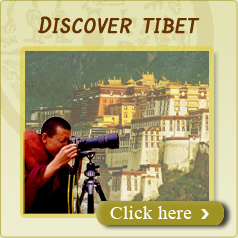Tibet Festivals
Tibetan festivals are held according to the Tibetan lunar calendar, which usually lags at least a month behind our Gregorian calendar. We have included forthcoming dates for some of the festivals listed below, but you will need to ask around for th eexact dates of many festivals because these are often only fixed by monasteries a few months in advance.
| Festivals |
2010 |
2011 |
2012 |
| Tibetan New Year |
Feb 9 |
Feb 21 |
Mar 3 |
| Monlam Festival |
Feb 16-Feb 25 |
Feb 28-Mar 7 |
Mar 11-Mar 19 |
| Butter Oil Lantern Festival |
Feb 23 |
Mar 6 |
Mar 18 |
| Saga Dawa Festival |
May 23 |
Jun 3 |
Jun 14 |
| Horse Racing Festival, Gyantse |
June |
June |
June |
| Chubacexi Festival |
July 10 |
Jul 21 |
Jul 2 |
| Yalong Cultural Festival |
July 25 |
July 25 |
July 25 |
| Shoton Festival |
Sep 3-Sep 10 |
Aug 15-Aug 22 |
Aug 27-Sep 3 |
| All dates are subject to change according to individual monasteries |
|
Annual Festival Calendar
January |
| Shigatse New Year festivals held in the first week of the 12th lunar month. |
February-March |
| Year End Festivals : Dancing monks can be seen on the 29th of the 12th lunar month in this festival which is held to dispel the evil of the old year and auspiciously usher in the new one . |
| New Year Festivals (Losar) : Taking place in the first week of the first lunar month , Losar is a colourful week of activities ; Lhasa is probably the best place to be . There are performances of Tibetan drama and pilgrims making incense offerings, and the streets are thronged with Tibetans dressed in their finest . Forthcoming dates :3 March 2003, 21 February 2004, 9 February 2005. |
| Lantern Festival : This is held on the 15th of the first lunar month ; huge yak-butter sculptures are placed around Lhasa's Barkhor circuit. Forthcoming dates: 18 March 2003, 6 March 2004, 23 February 2005. |
| Monlam (Great Prayer Festival) : Held midway through the first lunar month (officially culminating on the 25th). Monks from Lhasa 's three main monasteries assemble in the Jokhang and image of Jampa (Maitreya) from Lhasa 's Jokhang is borne around the Barkhor circuit, attracting enthusiastic crowds of locals and pilgrims . The festivals was first instituted by Tsongkhapa in 1409 at Gaden monastery. |
May-June |
| Birth of Sakyamuni (Sakya Thukpa) :This is not exactly a festival. But rather the seventh day of the fourth lunar month is an important pilgrims in the Holy City of Lhasa and other sacred areas in Tibet. Festivals are held at this time at Tsurphu (detailed following ), Gaden, Reting and Samye Monasteries. |
| Tsurphu Festival : Cham dancing (ritual dancing carried out by monks )and Chang drinking are the order of the day at this festivals on the 10th day of the fourth lunar month. The highlight used to be the dance of the Karmapa (the spiritual leader of the Karma Kagyupa suborder, now in India) so it remains to be seen how the festivals continues. |
| Saga Dawa (Sakyamuni's Enlightenment) : The 15th day of the fourth lunar month (full moon )marks the date of Sakyamuni's (Sakya Thukpa's) conception, moment of enlightenment and entry into nirvana . It is an occasion for outdoor operas and also sees large numbers of pilgrims climb Gephel Ri, the peak behind Drepung Monastery, to burn juniper incense. Saga Dawa is also a particularly good time to be at Mt. Kailash. Any kora is bursting with extra pilgrims . Forthcoming dates : 26 May 2002 , 14 June 2003 , 3 June 2004, 23 May 2005. |
June-July |
| World Incense Day : A day of incense burning and picnicking . |
| Gyantse Horse -Racing Festival : A traditional festivals whose date authorities are trying to fix to the middle of June to boost the number of tourists. The fun and games include dances,picnics, archery and equestrian events. |
| Worship of the Buddha during the second week of the fifth lunar month, the parks of the Lhasa , in particular the Norbulingka, are crowded with picnickers. |
| Tashilhunpo Festival : During the second week of the fifth lunar month, Shigatse's Tashilhunpo Monastery becomes the scene of a three-day festival, and a huge thanga is hung. |
| Samye Festivals : Held from the 15th day of the fifth lunar month (full moon )for two days Special ceremonies and cham dancing in front of the Utse are the main attractions. The monastery guesthouse is normally booked out at this time so bring a tent . |
|
|







